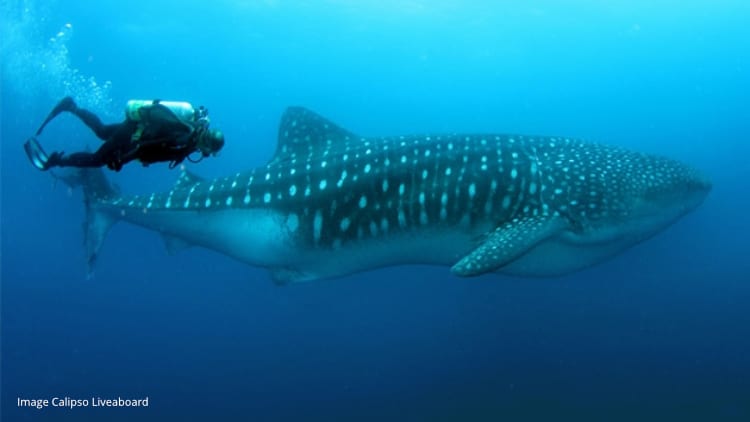Galapagos best time to visit
When do you want to visit the Galápagos Islands? The climate, tourism and animal life varies per season. Read here the best travel time and what you can expect ...

Who is not familiar with the nature documentaries where you see hundreds of sharks come together in the Galápagos Archipelago? The islands simply offer the best diving expeditions in the world. The legendary diving locations near the islands of Darwin and Wolf are considered by experienced divers to be the highlight of their diving career. But the Archipelago is also an iconic destination for less experienced divers. Where in the world can you find so much diversity of animal species that only live together here because of the unique climate?
Diving in the Galápagos Islands is an experience full of awe-inspiring encounters and emotional moments. The cold Humboldt current brings nutrient-rich water to the islands and the waters are highly protected. It results in an enchanting, unique world. Here you will find more than 400 species of fish, 17% of which are endemic to the Galápagos Islands. Shall we just give a sample of the population? Various shark species (27 in total!) Including white-tipped, black-tipped reef sharks, silky-, Galapagos- and hammerhead sharks, whale sharks (especially during the season between June and December), tuna species, dolphins, eagle rays, whales, scorpion fish, seahorses, red-lipped batfishes and the mysterious mola mola. The schools of fish are sometimes so large that they completely block the sunlight under water. In addition, also turtles abound, the endemic sea iguanas, naughty playful sea lions and last but not least the Galapagos penguin. Nowhere else in the world can you find these animal species living together and the chance to swim with sharks is almost 100%.
The islands are in particular a destination suitable for experienced divers. Certainly near the islands of Darwin and Wolf, but also at many other locations, the sea currents are powerful and unpredictable, which means that the conditions of diving can change quickly. You must have at least the PADI Advanced Open Water Diver certification and a PADI course drift diving is highly recommended. You must have logged at least 50 dives with recent diving experience (not more than 6 months ago).
Can I not dive here as a beginner? Certainly, you can even obtain your PADI certification on the Galápagos Islands! There are various diving locations around the central islands that are suitable for novice and less experienced divers. You must of course have the right expectations; you are not likely to spot a whale shark and certainly no large schools of hammerhead sharks. Nevertheless, your diving experience will be exciting and you will have a good chance of seeing sea turtles, sea lions, rays, various tropical fish and a single shark species.
The Galápagos has water temperatures ranging from 18-24˚C during the warm season from December to May and 16-22˚C during the cooler season from June to November. The currents can vary from 1 to 5 knots. Due to the strong currents and plankton-rich water, visibility can sometimes be very limited, generally between 10 and 25 meters.
Most divers are comfortable dressed in a 7 mm wetsuit from June to November with hood and gloves. A 5 mm wetsuit is usually sufficient in the warmer season. Naturally, water temperatures will vary from year to year and seasonal changes will fluctuate.
When best to go depends on your preferences and wishes.
During the warm season visibility is better and the water calmer. During this period you have a better chance of seeing hammerhead sharks, silky sharks and Galapagos sharks. In addition, this period is also called “manta season”. During these months there is a much greater chance of spotting various types of rays: giant mantas and beautiful schools of spotted eagle rays, golden rays, marble rays, mobula rays and cow-nosed rays.
During the cooler season the currents are stronger and the visibility is less. At this time, however, underwater life is also richer and you have the chance to dive with whale sharks around the islands of Darwin and Wolf.
You can visit the islands in two ways.
If you want to experience the underwater life at Darwin and Wolf as an experienced diver, you need to book a liveaboard diving cruise. Almost all of these cruises are 8 days, 7 nights in length and take you to the islands of Darwin, Wolf, the west of Isabela and Fernandina in addition to a few dive sites around the central islands. During the trip you will make a total of 18 to 20 dives, interspersed with a few land excursions. Book far in advance! There are only a handful of ships available that are fully booked up to two years in advance, certainly in the high season.
For novice divers or travellers with a somewhat smaller budget, it is possible to stay in a nice hotel in Puerto Ayora on the island of Santa Cruz and from there make diving excursions. You go to Rocas Gordon, Seymour Norte, Islote Mosquera, Floreana, Bartolomé, Rocas Beagle, Pinzón, Guy Fawkes, Daphne Minor or Santa Fe. Here too it is advisable to book in advance. The best diving schools and locations are quickly full and not every day there are excursions to all locations.
A diving vacation to the Galapagos Islands is an unforgettable experience for divers of all levels and offers unparalleled encounters. Contact us to discuss the options.